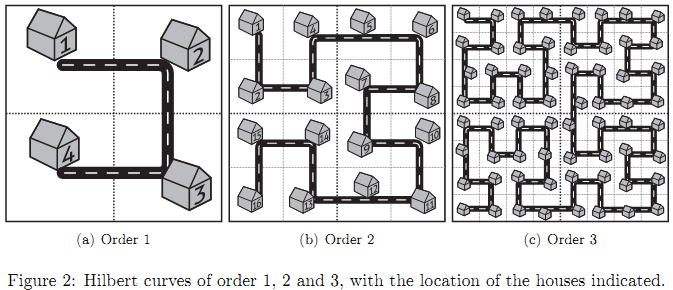Fractal Streets
Description
With a growing desire for modernization in our increasingly larger cities comes a need for new street designs. Chris is one of the unfortunate city planners responsible for these designs. Each year the demands keep increasing, and this year he has even been asked to design a completely new city.
More work is not something Chris needs right now, since like any good bureaucrat, he is extremely lazy. Given that this is a character trait he has in common with most computer scientists it should come as no surprise that one of his closest friends, Paul, is in fact a computer scientist. And it was Paul who suggested the brilliant idea that has made Chris a hero among his peers: Fractal Streets! By using a Hilbert curve, he can easily fill in rectangular plots of arbitrary size with very little work.
A Hilbert curve of order 1 consists of one "cup". In a Hilbert curve of order 2 that cup is replaced by four smaller but identical cups and three connecting roads. In a Hilbert curve of order 3 those four cups are in turn replaced by four identical but still smaller cups and three connecting roads, etc. At each corner of a cup a driveway (with mailbox) is placed for a house, with a simple successive numbering. The house in the top left corner has number 1, and the distance between two adjacent houses is 10m.
The situation is shown graphically in figure 2. As you can see the Fractal Streets concept successfully eliminates the need for boring street grids, while still requiring very little effort from our bureaucrats.
As a token of their gratitude, several mayors have offered Chris a house in one of the many new neighborhoods built with his own new scheme. Chris would now like to know which of these offerings will get him a house closest to the local city planning office (of course each of these new neighborhoods has one). Luckily he will not have to actually drive along the street, because his new company "car" is one of those new flying cars. This high-tech vehicle allows him to travel in a straight line from his driveway to the driveway of his new office. Can you write a program to determine the distance he will have to fly for each offier (excluding the vertical distance at takeoff and landing)?
Input
On the first line of the input is a positive integer \(T\), the number of test cases(\(T \le 10^4\)). Then for each test case:
A line containing a three positive integers, \(n < 31\) and \(h, o < 2^{2N}\), specifying the order of the Hilbert curve, and the house numbers of the offered house and the local city planning office.
Output
For each test case:
One line containing the distance Chris will have to fly to his work in meters, rounded to the nearest integer.
Samples
Sample #1
Input
3
1 1 2
2 16 1
3 4 33
Output
10
30
50
Simplified
给你一个原始的分形图, \(t\) 组数据,对于每组数据,输入 \(3\) 个数 \(n, h, o\) 。
( \(n\) 为在第 \(n\) 级, \(h\), \(o\) 为两个房子的编号 )
我们要求求在第 \(n\) 级情况下,编号为 \(h\) 和 \(o\) 的两个点之间的距离为多少。
( 输出的值要四舍五入到整数 )
其中,第 \(n\) 级分形图形成规则如下:
- 在右下角和右上角复制一遍 \(n-1\) 情况下的分形图
- 将 \(n-1\) 情况下的分形图逆时针旋转 \(90\) 度,放到左上角
- 将 \(n-1\) 情况下的分形图顺时针旋转 \(90\) 度,放到左下角
编号是从左上角那个点开始计 \(1\),沿着道路计数。
(从左到右分别是一到三级的分形图,小正方形的边长为10,点在小正方形的正中央)
Source
算法竞赛进阶指南 POJ
信息
- ID
- 1009
- 难度
- 9
- 分类
- (无)
- 标签
- (无)
- 递交数
- 8
- 已通过
- 2
- 通过率
- 25%
- 上传者
